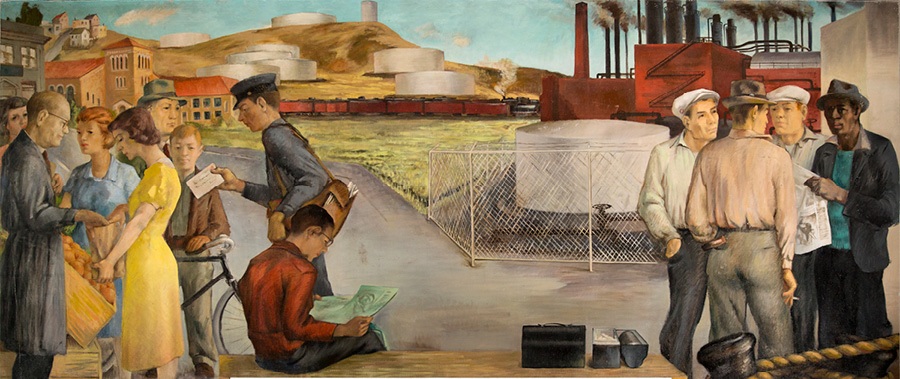Painter of the Lost Art
When Melinda McCrary got wind of a 10-foot-long New Deal-era mural that had been missing for decades from Richmond’s main post office, she immediately set out to hunt it down. The mural by Victor Arnautoff, a former assistant to Diego Rivera, showed blue-collar workers, people buying groceries and the city’s oil refineries. It was one of many he did in the 1930s and 1940s under a federally funded program that encouraged artists to create public artworks reflective of the American scene. The downtown post office underwent a renovation in 1976, and the mural was apparently rolled up, stashed away in a basement and forgotten. Many assumed it had been tossed in the trash.
Not McCrary, the executive director at the Richmond Museum of History. She started asking questions.
“Then I found this janitor,” she says. “The lights had been out in this one room for who knows how long. Maybe years. He shone his flashlight on this 12-foot-high crate, and I said, ‘There it is!’”

Two years later, a full-scale photographic reproduction of the mural is being shown at SF State’s Special Collections Gallery as part of an exhibit on Arnautoff, widely recognized today as a leading artist of the era. The exhibit also includes reproductions of murals he did at the Presidio Chapel and at George Washington High School. Prints related to the San Francisco General Strike of 1934 (which led to widespread unionization of West Coast ports) and a collection from the archives of the California Labor School, where Arnautoff taught in the 1940s, are also on display.
“We’re pulling in his history and trying to understand the larger role that he had in the Bay Area as a significant artist here and nationally,” says Catherine Powell, associate librarian at SF State’s Labor Archives and Research Center.
The exhibit was co-curated by Professor Emeritus of History Robert Cherny, one of the founders of the Labor Archive, which was established in 1985 to preserve the region’s rich working-class history. Cherny recently published a book about the artist: Victor Arnautoff and the Politics of Art. Like his mentor, Diego Rivera, Arnautoff wanted art to be accessible to the masses, and his murals were intended to be moving and to stimulate thinking, Cherny said.
“He referred to himself as a social realist, and he’s an interesting example of things going on generally in the art world and of the connection between the art world and the New Deal,” he says.
The exhibit, located on the 4th floor of SF State’s J. Paul Leonard Library, runs through Dec. 12.
New Division to Enhance Equity, Inclusion
SF State has formed a new division to promote equity and inclusion, advance social justice, improve the campus climate for all students and facilitate intercultural and intergroup dialogue. The Division of Equity & Community Inclusion opened its doors this fall. It works with student clubs and organizations and other campus partners to close the educational equity gap in support of the Graduation Initiative 2025, which seeks to raise retention and graduation rates, strengthen student learning and improve the student experience at all levels.
Manuel Alejandro Pérez is serving as interim assistant vice president for Equity & Community Inclusion. He identifies as a queer Xicanx and is a native Spanish speaker and Sacramento native who comes from a Mexican migrant and immigrant background. The University plans to conduct national searches to appoint a director of a new Black Unity Center and a director of the Office of Diversity & Student Equity. In the meantime, Associate Professor of Africana Studies Serie McDougal and Aimee Zenzele Barnes will serve as interim directors, respectively. Barnes has been interim executive director of Associated Students at SF State since 2014.
“This is a historic milestone for SF State, and the real work to bring about greater equity, inclusion and social justice on our campus is only just beginning,” Vice President for Student Affairs & Enrollment Management Luoluo Hong says.
The Black Unity Center will host speakers and cultural events and will also offer academic support and career advising.
“The College of Ethnic Studies has served a lot of these functions, but more of these types of programs are in need on campus, with more funding and in a more coordinated fashion,” says McDougal. “It’s all related to raising retention and graduation rates and student engagement.”